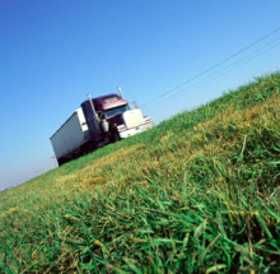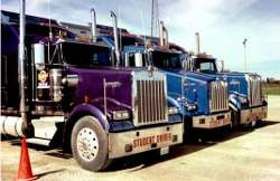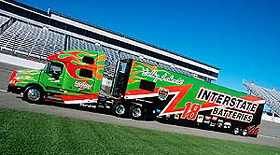Direction To Slide Tandems
Topic 16421 | Page 1
Sliding tandems forward will move weight to the back. I made a mental picture of Atlas moving under the earth to shoulder the weight. Sliding tandems to the rear will transfer weigh to the front.
Tandems:
Tandem Axles
A set of axles spaced close together, legally defined as more than 40 and less than 96 inches apart by the USDOT. Drivers tend to refer to the tandem axles on their trailer as just "tandems". You might hear a driver say, "I'm 400 pounds overweight on my tandems", referring to his trailer tandems, not his tractor tandems. Tractor tandems are generally just referred to as "drives" which is short for "drive axles".
Tandem:
Tandem Axles
A set of axles spaced close together, legally defined as more than 40 and less than 96 inches apart by the USDOT. Drivers tend to refer to the tandem axles on their trailer as just "tandems". You might hear a driver say, "I'm 400 pounds overweight on my tandems", referring to his trailer tandems, not his tractor tandems. Tractor tandems are generally just referred to as "drives" which is short for "drive axles".

Thanks Deb R. I will try to remember this on my next weigh.

There is also a very nice app that will provide that info along with a basic calculation per hole.
Truckers Slide calc ver2.2.6
Duane all your questions will be answered, and you'll learn a lot on this whole subject by going through the "weights and balance" section of our High Road Training Program.
It will make your life so much easier out here, and you'll have the confidence of a professional as you are doing your daily tasks as a driver.
CDL:
Commercial Driver's License (CDL)
A CDL is required to drive any of the following vehicles:
- Any combination of vehicles with a gross combined weight rating (GCWR) of 26,001 or more pounds, providing the gross vehicle weight rating (GVWR) of the vehicle being towed is in excess of 10,000 pounds.
- Any single vehicle with a GVWR of 26,001 or more pounds, or any such vehicle towing another not in excess of 10,000 pounds.
- Any vehicle, regardless of size, designed to transport 16 or more persons, including the driver.
- Any vehicle required by federal regulations to be placarded while transporting hazardous materials.

When weighing my truck by axle; Say the drives are over weight, which direction should I slide the tandems? Say I am over weight on the trailer, which direction should the tandems be slide and how much weight does each hole represent? Can anyone help me figure this thing out?
Slide tandems towards the problem. Each hole is about 250 lbs for dry van , about 350-400 lbs for reefer
Tandems:
Tandem Axles
A set of axles spaced close together, legally defined as more than 40 and less than 96 inches apart by the USDOT. Drivers tend to refer to the tandem axles on their trailer as just "tandems". You might hear a driver say, "I'm 400 pounds overweight on my tandems", referring to his trailer tandems, not his tractor tandems. Tractor tandems are generally just referred to as "drives" which is short for "drive axles".
Tandem:
Tandem Axles
A set of axles spaced close together, legally defined as more than 40 and less than 96 inches apart by the USDOT. Drivers tend to refer to the tandem axles on their trailer as just "tandems". You might hear a driver say, "I'm 400 pounds overweight on my tandems", referring to his trailer tandems, not his tractor tandems. Tractor tandems are generally just referred to as "drives" which is short for "drive axles".
Dry Van:
A trailer or truck that that requires no special attention, such as refrigeration, that hauls regular palletted, boxed, or floor-loaded freight. The most common type of trailer in trucking.Reefer:
A refrigerated trailer.
Do the High Road Training on weights and balances as OS suggested.
Do it FEW TIMES, as it will be slightly confusing the first time through - then become more and more obvious each time you go through it.
Also keep in mind there are LIMITS to how FAR BACK you can have your trailer tandems in many states.
You have to be able to get your axle sets LEGAL, while staying within the legal limits (Bridge Laws) for distances between axles.
If you can't get LEGAL for both weight and axle distances - the load will need to be re-worked.
DO THE HIGH ROAD TRAINING - and come back to this thread if you still have questions.
Rick
Tandems:
Tandem Axles
A set of axles spaced close together, legally defined as more than 40 and less than 96 inches apart by the USDOT. Drivers tend to refer to the tandem axles on their trailer as just "tandems". You might hear a driver say, "I'm 400 pounds overweight on my tandems", referring to his trailer tandems, not his tractor tandems. Tractor tandems are generally just referred to as "drives" which is short for "drive axles".
Tandem:
Tandem Axles
A set of axles spaced close together, legally defined as more than 40 and less than 96 inches apart by the USDOT. Drivers tend to refer to the tandem axles on their trailer as just "tandems". You might hear a driver say, "I'm 400 pounds overweight on my tandems", referring to his trailer tandems, not his tractor tandems. Tractor tandems are generally just referred to as "drives" which is short for "drive axles".

There is also a very nice app that will provide that info along with a basic calculation per hole.
Truckers Slide calc ver2.2.6
I have and use this app myself... it's bloody awesome because not only will it help you get your axle weights legal, it'll help you have the best balance too which makes for a smoother ride and better fuel economy.
Also keep in mind not all tandem hols are the same. my company's trailers have 2 different kinds of spacing. 4" and 6" apart on the holes. So the amount of weight per hole is not the same on all trailers. for the most part it seems our older ones are 6" apart and newer ones are 4" but I check every time and I use that app.
Tandem:
Tandem Axles
A set of axles spaced close together, legally defined as more than 40 and less than 96 inches apart by the USDOT. Drivers tend to refer to the tandem axles on their trailer as just "tandems". You might hear a driver say, "I'm 400 pounds overweight on my tandems", referring to his trailer tandems, not his tractor tandems. Tractor tandems are generally just referred to as "drives" which is short for "drive axles".
Compare the Drive weight with the Tandem weight. If the Drive is heavier, move the Tandems toward the heavy weight. If the Tandems are heavier, move the Tandems away (back) from the weight.
Secret mathematical formula: Subtract the smaller from the larger (just like in school). Divide that number by 500, round up (4.25 becomes 5). That is the number of 4" spaced holes to move.
Drives // Tandem: 31120 // 34760
Difference: 34760 - 31120 = 3640
Divide by 500: 3640 ÷ 500 = 7.28
Round "up": 8 holes. The heaviest is the Tandems, so move them back 8 holes. Do not get comfused here: to move the tandems back, you need to keep tandem brakes on and move the truck forward.
Tandems:
Tandem Axles
A set of axles spaced close together, legally defined as more than 40 and less than 96 inches apart by the USDOT. Drivers tend to refer to the tandem axles on their trailer as just "tandems". You might hear a driver say, "I'm 400 pounds overweight on my tandems", referring to his trailer tandems, not his tractor tandems. Tractor tandems are generally just referred to as "drives" which is short for "drive axles".
Tandem:
Tandem Axles
A set of axles spaced close together, legally defined as more than 40 and less than 96 inches apart by the USDOT. Drivers tend to refer to the tandem axles on their trailer as just "tandems". You might hear a driver say, "I'm 400 pounds overweight on my tandems", referring to his trailer tandems, not his tractor tandems. Tractor tandems are generally just referred to as "drives" which is short for "drive axles".

Thanks Old School for the tip on High Road Training Program. I will definitely look into it and study it. appreciate all the help and advice I can get out here.
Duane all your questions will be answered, and you'll learn a lot on this whole subject by going through the "weights and balance" section of our High Road Training Program.
It will make your life so much easier out here, and you'll have the confidence of a professional as you are doing your daily tasks as a driver.
Duane all your questions will be answered, and you'll learn a lot on this whole subject by going through the "weights and balance" section of our High Road Training Program.
It will make your life so much easier out here, and you'll have the confidence of a professional as you are doing your daily tasks as a driver.
CDL:
Commercial Driver's License (CDL)
A CDL is required to drive any of the following vehicles:
- Any combination of vehicles with a gross combined weight rating (GCWR) of 26,001 or more pounds, providing the gross vehicle weight rating (GVWR) of the vehicle being towed is in excess of 10,000 pounds.
- Any single vehicle with a GVWR of 26,001 or more pounds, or any such vehicle towing another not in excess of 10,000 pounds.
- Any vehicle, regardless of size, designed to transport 16 or more persons, including the driver.
- Any vehicle required by federal regulations to be placarded while transporting hazardous materials.
New Reply:
New! Check out our help videos for a better understanding of our forum features

















Preview:








 TT On Facebook
TT On Facebook
When weighing my truck by axle; Say the drives are over weight, which direction should I slide the tandems? Say I am over weight on the trailer, which direction should the tandems be slide and how much weight does each hole represent? Can anyone help me figure this thing out?
Tandems:
Tandem Axles
A set of axles spaced close together, legally defined as more than 40 and less than 96 inches apart by the USDOT. Drivers tend to refer to the tandem axles on their trailer as just "tandems". You might hear a driver say, "I'm 400 pounds overweight on my tandems", referring to his trailer tandems, not his tractor tandems. Tractor tandems are generally just referred to as "drives" which is short for "drive axles".
Tandem:
Tandem Axles
A set of axles spaced close together, legally defined as more than 40 and less than 96 inches apart by the USDOT. Drivers tend to refer to the tandem axles on their trailer as just "tandems". You might hear a driver say, "I'm 400 pounds overweight on my tandems", referring to his trailer tandems, not his tractor tandems. Tractor tandems are generally just referred to as "drives" which is short for "drive axles".